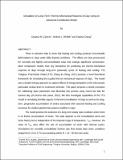Simulation of long-term thermo-mechanical response of clay using an advanced constitutive model
Author(s)
Zymnis, Despina M; Whittle, Andrew J; Cheng, Xiaohui
Download11440_2018_726_ReferencePDF.pdf (4.188Mb)
Open Access Policy
Open Access Policy
Creative Commons Attribution-Noncommercial-Share Alike
Terms of use
Metadata
Show full item recordAbstract
Abstract
There is extensive data to show that heating and cooling produces irrecoverable deformations in clays under fully drained conditions. The effects are most pronounced for normally and lightly overconsolidated clays that undergo significant compression. Most constitutive models have key limitations for predicting the thermo-mechanical response of clays through long-term (seasonal) cycles of heating and cooling. The Tsinghua ThermoSoil model (TTS; Zhang and Cheng in Int J Numer Anal Methods Geomech 41(4):527–554, 2017) presents a novel theoretical framework for simulating the coupled thermo-mechanical response of clays. The model uses a double-entropy approach to capture effects of energy dissipation at the microscopic particulate contact level on continuum behavior. This paper proposes a simple procedure for calibrating input parameters and illustrates this process using recent laboratory data for Geneva Clay (Di Donna and Laloui in Eng Geol 190:65–76, 2015). We then investigate capabilities of the TTS model in simulating familiar aspects of thermal consolidation of clays as well as the long-term, progressive accumulation of strains associated with seasonal heating and cooling processes for shallow geothermal systems installed in clays. The model predicts the existence of a long-term steady-state condition where there is no further accumulation of strain. This state depends on the consolidation stress and stress history but is independent of the imposed range of temperature, Tcyc. However, the value of Tcyc does affect the rate of accumulation of strain with thermal cycles. Simulations for normally consolidated Geneva Clay find steady-state strain conditions ranged from 2.0 to 3.7% accumulating within N = 10–50 thermal cycles.
Date issued
2018-10-31Department
Massachusetts Institute of Technology. Department of Civil and Environmental EngineeringPublisher
Springer Berlin Heidelberg